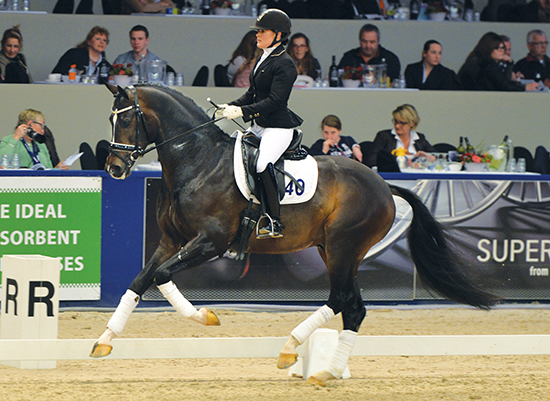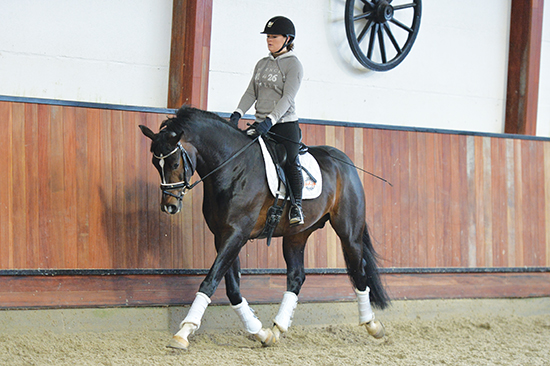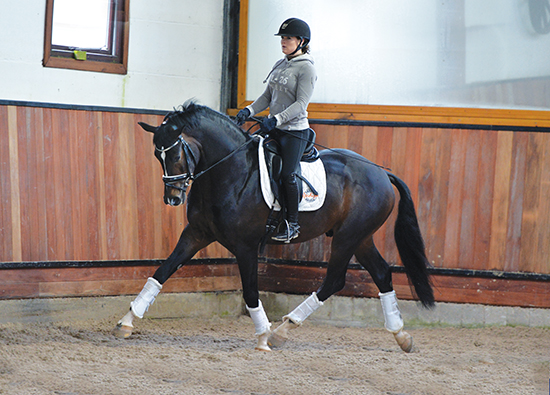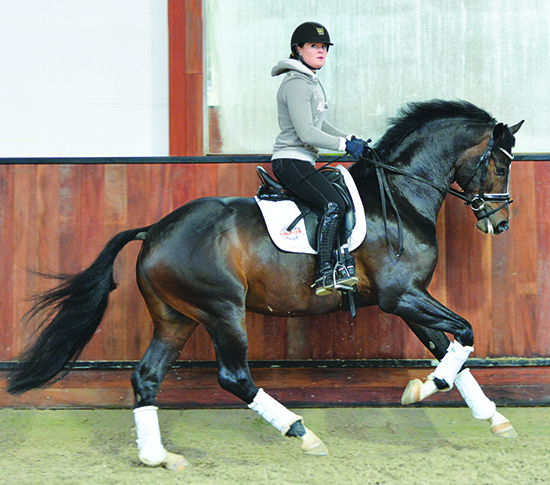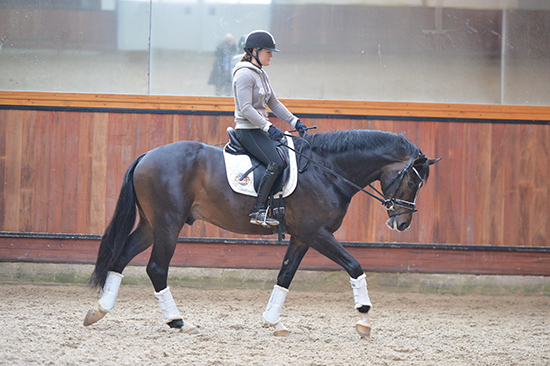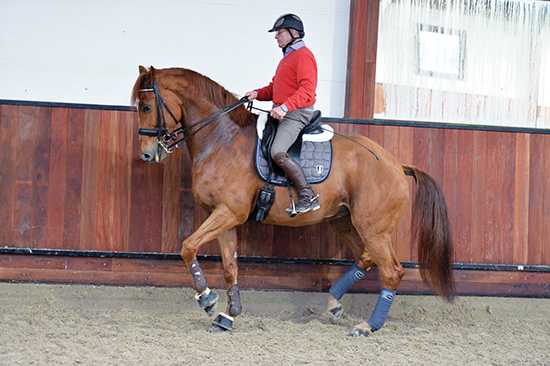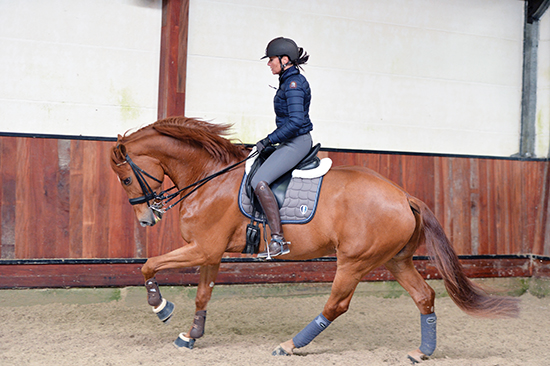VIEW PART TWO HERE:
http://www.horsemagazine.com/thm/2015/06/sitting-in-the-hall-watching-great-training-part-two/
Story by Chris Hector & Photos by Roz Neave
Gotcha, or to give him his full title, Gotcha-Utopia (since he is out of the famed Utopia line of mares) is a licensed KWPN stallion. He is by Ziesto, who suddenly became Glock’s Ziesto when the Glocks purchased Edward Gal and Hans Peter Minderhoud and set about buying ponies for them to ride. Ziesto is by Lancet, who was an international Grand Prix horse with Imke Schellekens-Bartels and then Emma Hindle.
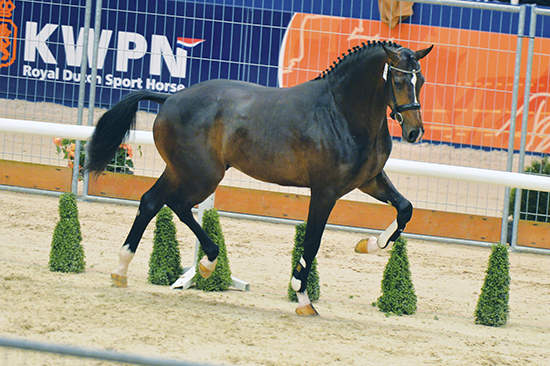 Gotcha at the 2014 KWPN licensing
Gotcha at the 2014 KWPN licensing
And Jennifer showing off Gotcha at this year’s licensing
Jennifer is a little embarrassed by the stallion’s name, and is a little relieved when we explain that gotcha works fine where we come from. He is certainly a most attractive horse.
After the working session I was talking with Jennifer about her different approaches to different horses…
It seemed to me that the way you achieved the balance with Forty was quite different to the way you achieved the balance with Gotcha, with Forty you were getting the balance even in walk, and by the time you went to canter, he was already in balance, and that in the canter, you increased the balance before you went to trot, and you had the balance in trot and canter with Forty, before you made it bigger – but with Gotcha, it was more conventional, first the power to push, to go forward, then the power to carry came second – is that because they are two different horses, or because one is one year older…
Working at home this year
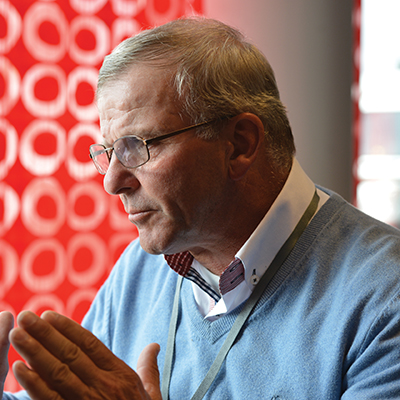 Jennifer’s partner and trainer, Johan Hamminga comments:
Jennifer’s partner and trainer, Johan Hamminga comments:
“Forty is older and much more ridden than Gotcha. Gotcha is three years old, turning four this year, so he only has to learn to go forward and accept the leg. Now in the canter, in the last part before I came to trot, I thought you saw that he has learnt lately to collect a little bit, for a three-year-old, so he can make a nice transition. In the canter he can now collect a little and make nice transitions, so I think that is the beginning, in a year he will be different.”
“The photo is taken when the horse is in the corner, a little bit in the bending, and it shows especially the distance between the footfalls of the hind leg and the footfalls of the front leg – they are exactly even, and still you can see a lot of relaxation, and that he is in balance on both reins. A minus point is that when he is in the bending, his body is a little bit closed, he does not stretch, so it looks as if he does not stretch enough. He is smooth in his mouth on both reins, he looks well. That is a working trot but he looks good in this moment.”
“There is a lot of uphill tendency in this picture, especially for a three-and-a-half year old horse, the wither is much much higher than the croup, the horse is steady on the bit, on the vertical, it could be a little bit higher in the poll perhaps. Especially his right hind leg is far under the body, under the vertical line from Jennifer and is lower to the ground than the left front leg, there is no disuniting, this is true canter. Sometimes in the canter, the outside front leg of the diagonal is earlier on the ground than the inside hind leg, and then the horse is disunited, he is out of balance. Here you see the inside hind leg is for a very short moment, earlier on the ground, that is the reason he is so uphill. Normally you have outside hind leg, diagonal, inside front leg, but when the diagonal is a little broken because the inside hind leg is for a short moment, earlier on the ground, then you have the best canter there is. This is also the canter you need in the pirouettes. But when his front leg is a moment earlier on the ground, then you are out of balance, and have a very bad canter.”
“When it is in four beats, then that is positive for me, when you are dancing in the rhythm, in the beat, with your partner, then you are a good dancer, but when you are out of the beat, out of the rhythm, then your partner says I don’t want to dance with you. Three beat is normal for a canter, but when he is in four beat, when his inside hind leg is for a short moment earlier on the ground – but when his outside front leg is earlier on the ground, then it is out of the beat, and that is negative.”
“Everybody can tell what is a good walk, a good walk is a walk in the four beat, a walk with a lot of ground covering, forming a vee that is the same between the front legs and the hind legs, but one of the most important things, especially for a trainer, is how does the horse in the walk, use his body, keep his balance, and how is his top line.”
Johan has a new pupil, Grand Prix rider, Christa Larmoyeur, and her nine-year-old gelding, Aston Martin NL. The exceptionally tall chestnut, is by Uphill out of a Cabochon mare, and represented The Netherlands at the World Young Dressage Horse Champs, two years running. Christa was until recently training with Anky van Grunsven, and polite as he is, Johan has obviously had to do quite a lot of retraining. Johan hops on board, and is working on the piaffe, one handed. He explains why piaffe, and not piaffe and passage:
“At this stage, we don’t do passage. Hubertus Schmidt taught that to me, when you have a problem, make a solution to that problem and don’t ask the horse to work on all the other problems, or you will make him crazy in the head. One month ago, when Christa went to collect, the horse was swinging left and right and really strong – now he gets better in the balance and narrower in the hind legs. It is important to have him in front of you and loosen the reins, then he can become looser and better balanced and more confident.”
“I met Johan at a stallion show, he came to me and said he liked the horse. In my early days I trained with Johan, so I thought I would go back to him to start piaffe and passage.”
What do you find valuable about him as a trainer?
“He knows how to explain the feeling you must have. It is not difficult to understand – when I give an aid, my horse has to react immediately, that is easy to explain.”
It’s good to have someone who will get on and ride the horse?
“Yeah, he did it one month ago, I asked him to, because I train a lot of students and most of the time, it always looks the same as it feels, but sometimes, it is different. My horse always looks very cool, he isn’t at all, so I asked Johan to sit on the horse and feel exactly what I am feeling, then he can help me much better. When he looked at the horse, he often said, more leg, more leg, make him more electric but when you are on that horse, he is really hot, and you have to say oh oh all the time. It looks really different and it helped when he felt it.”
Your horse looked great with Johan riding him?
“He was really astonished because he hadn’t sat on him for a month, and he has improved so much in those few weeks, he said ‘Wow, it is really completely different from a month ago!’ More balance, and loose in front, because in the beginning he didn’t have the balance and he was leaning a little in my hand – now it is much better, he has the balance and he comes back, his weight is a little bit more on his hindquarters, then in front we always have a light good feeling, it’s really nice.”
How ambitious are you with the horse?
“I had a horse before him, and I was 29th on the FEI world ranking, and I want to improve that, I want to become 28th or something, improve that 29, so I am kind of ambitious. I don’t want to spoil him. He is really big so I have to take time and be really careful with him, don’t try to do everything too fast. But I do want to go to all those beautiful shows again…”
“We had our first Grand Prix about four months ago for a 70%, but there were a lot of faults in it so he can do much better I think, I hope.”
VIEW PART TWO HERE:
http://www.horsemagazine.com/thm/2015/06/sitting-in-the-hall-watching-great-training-part-two/

